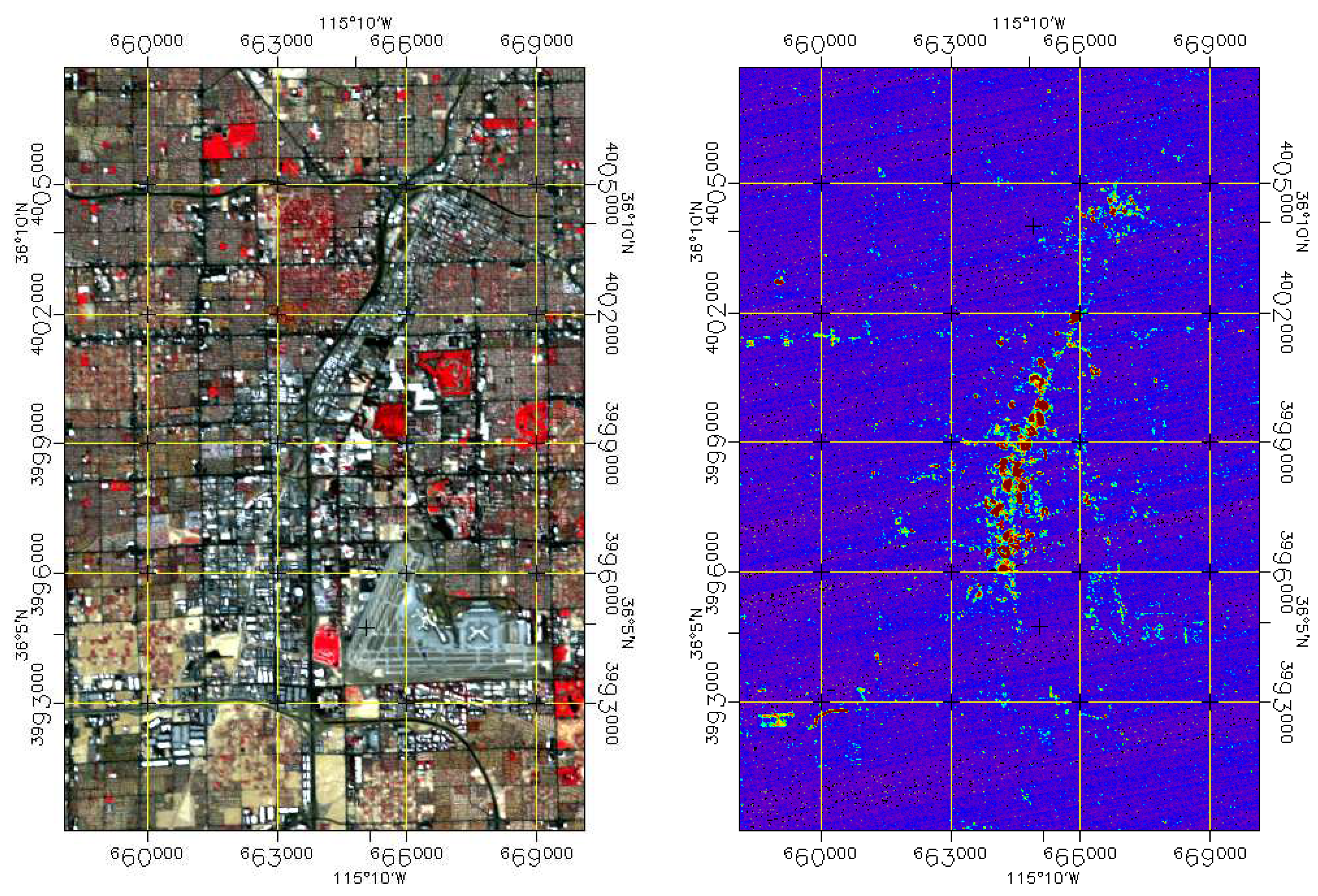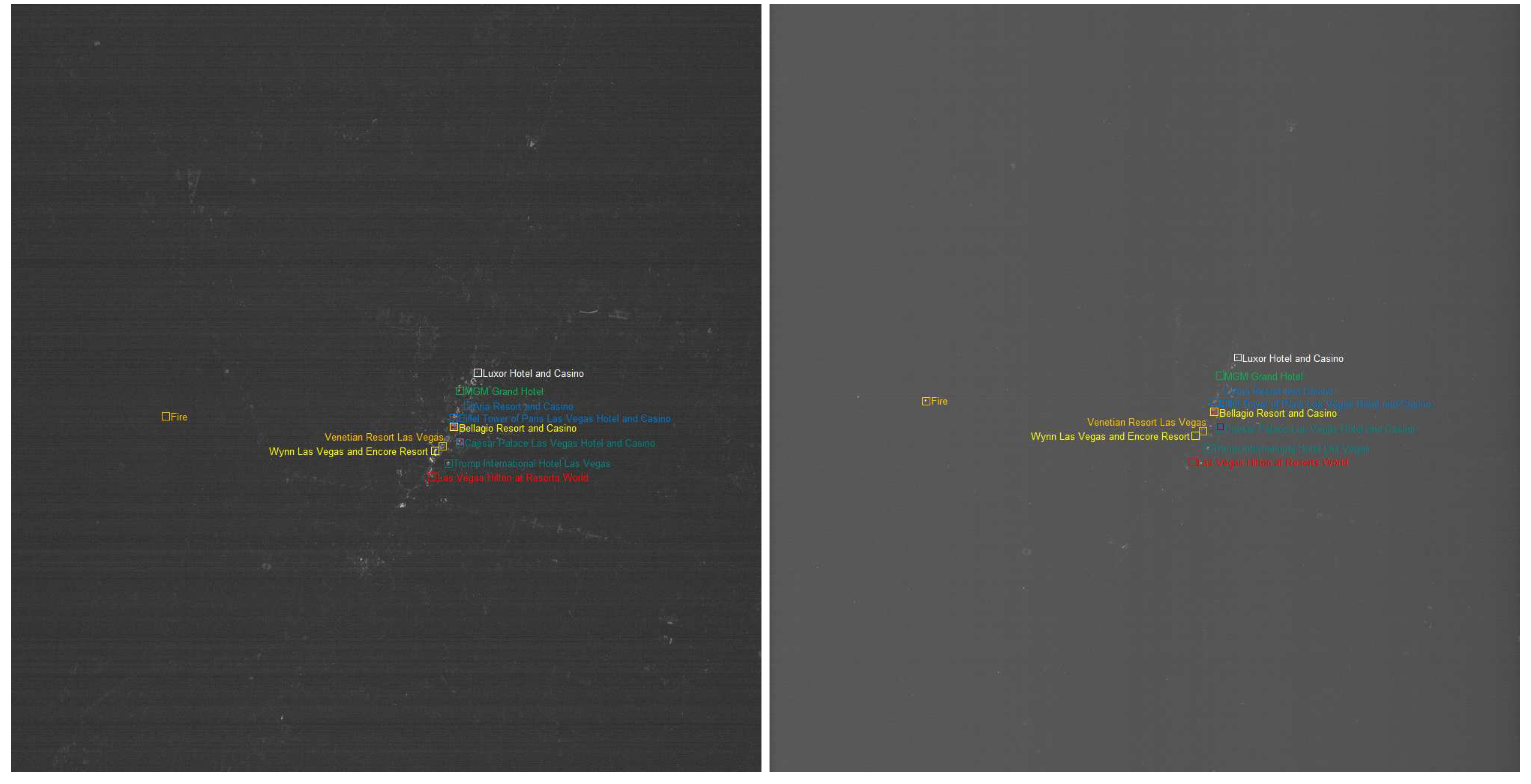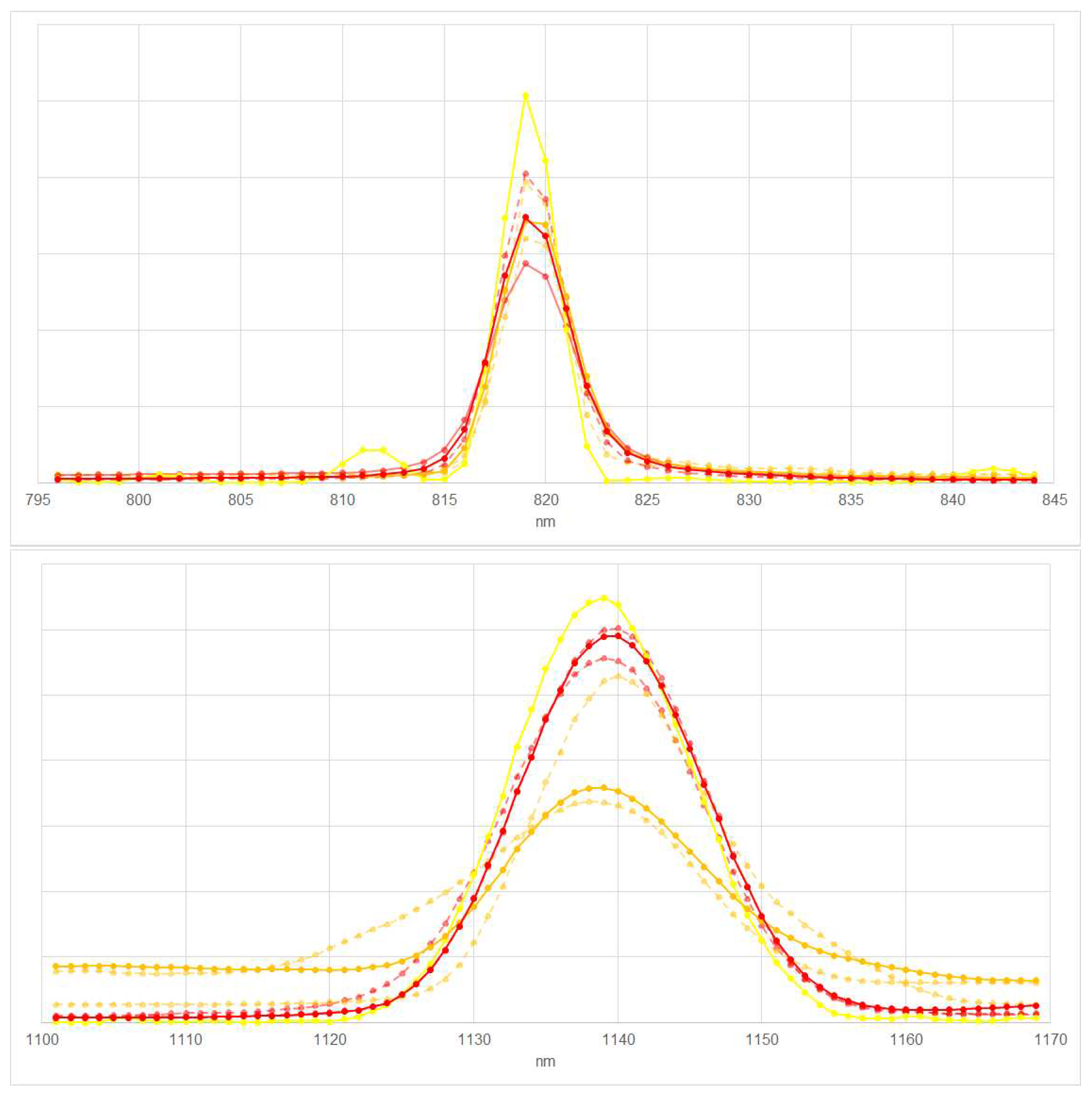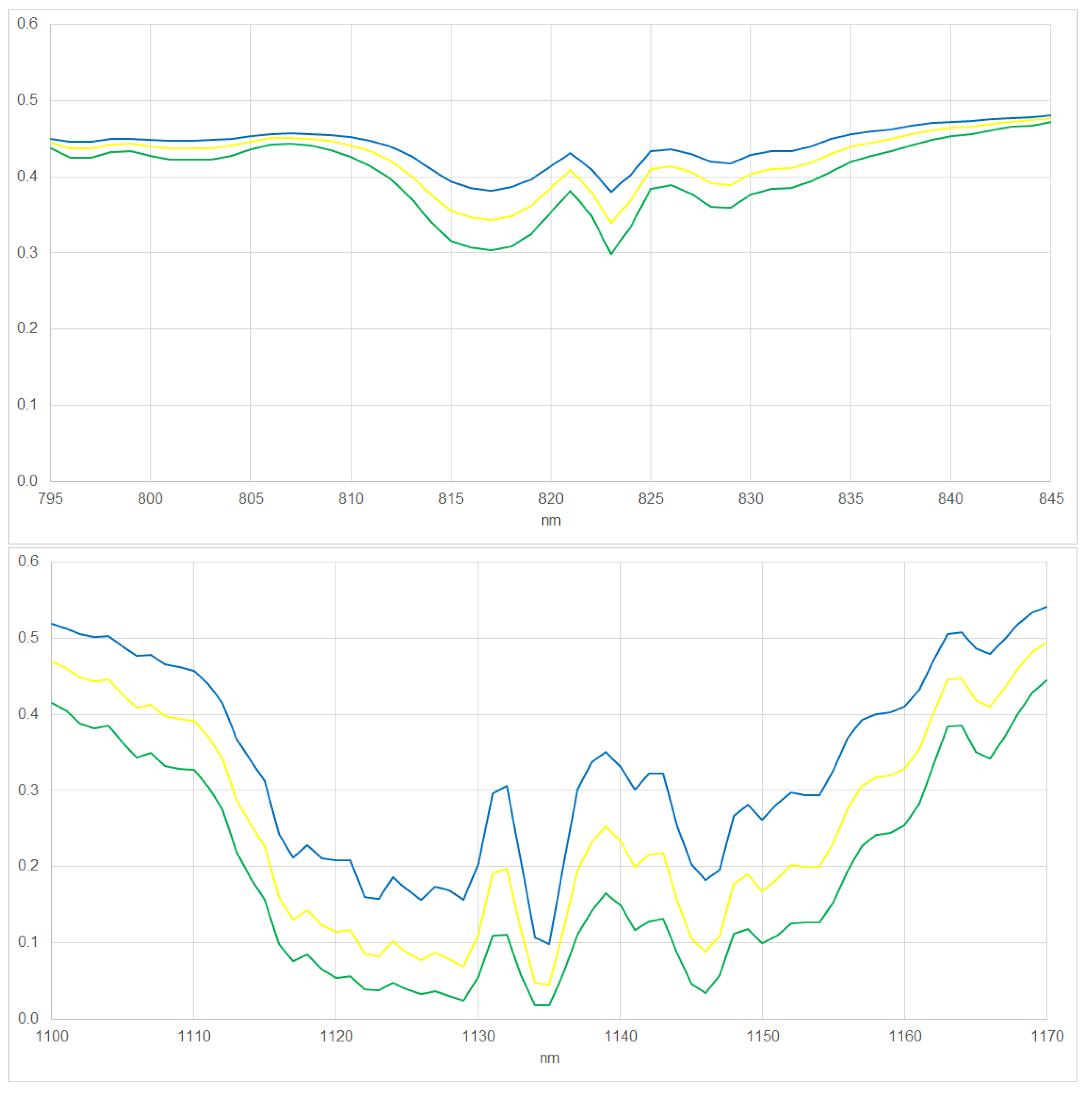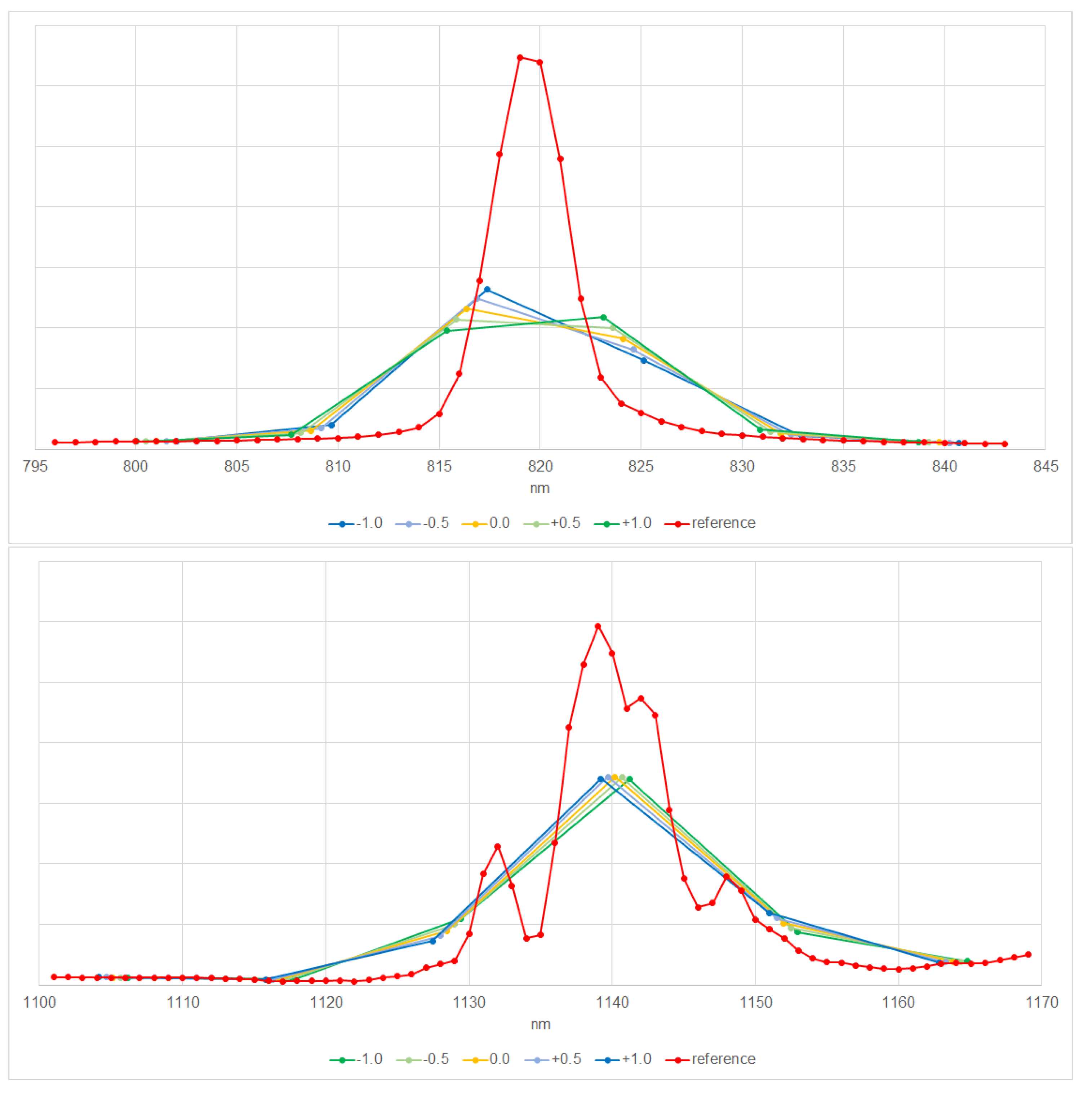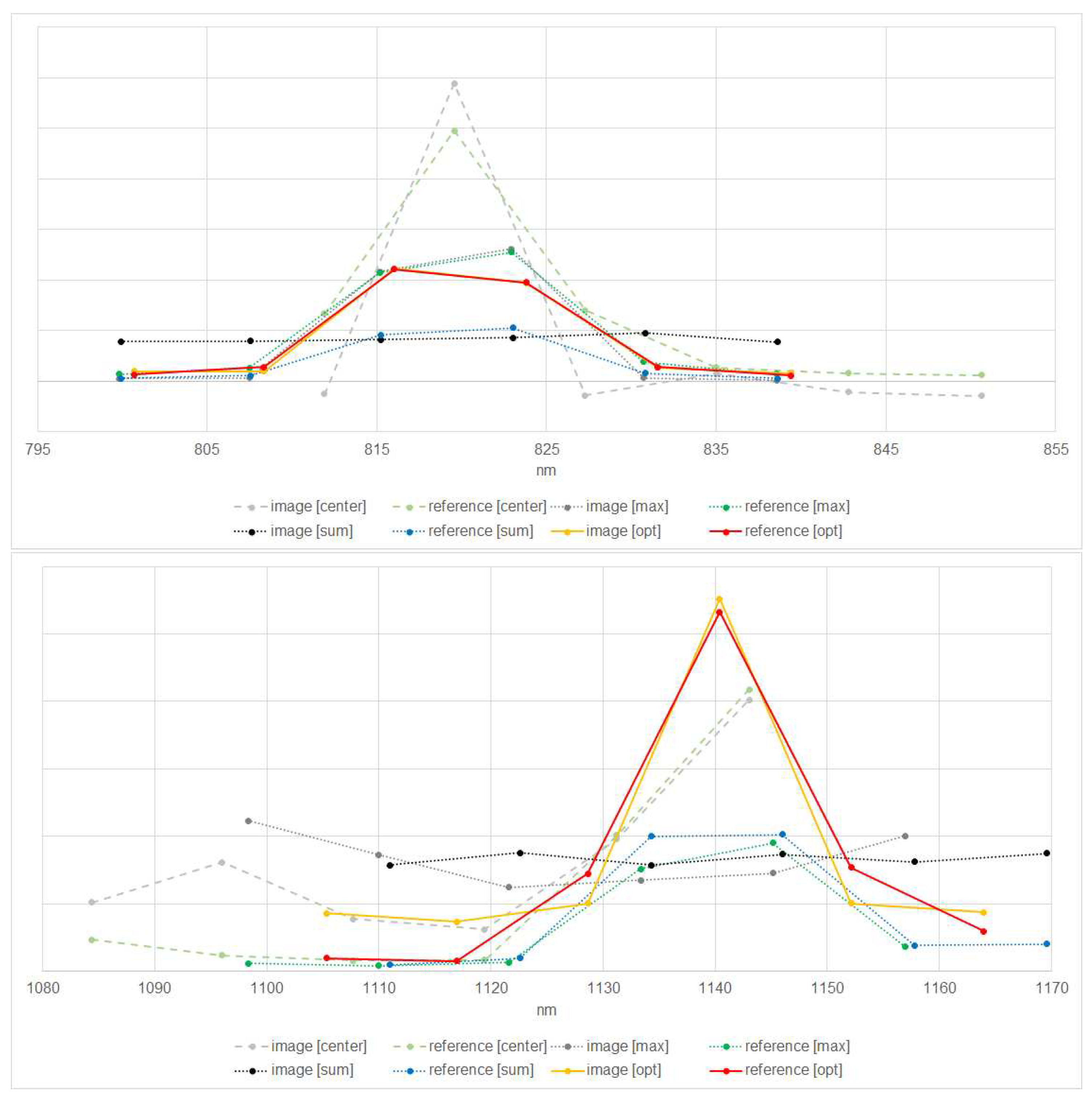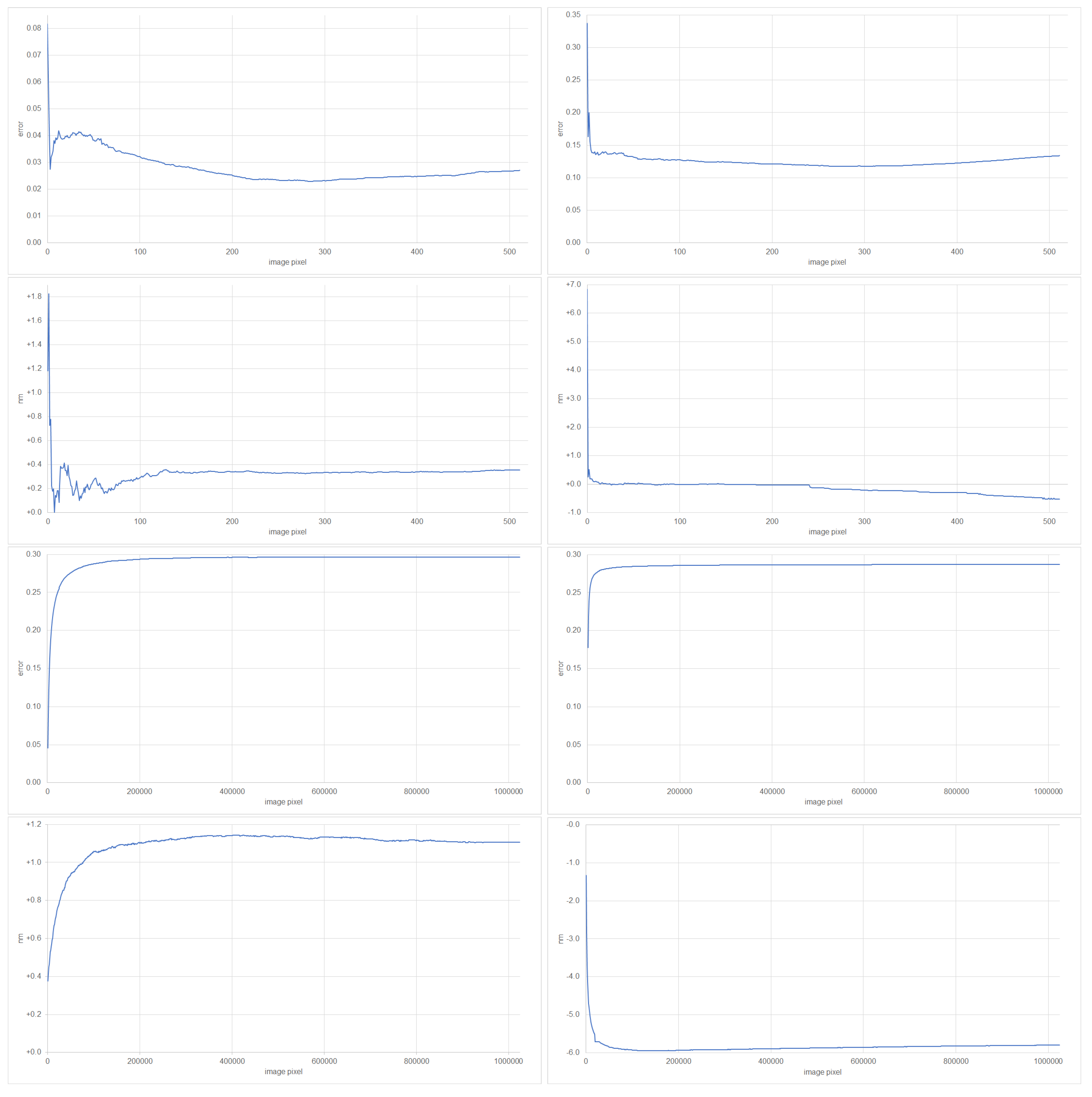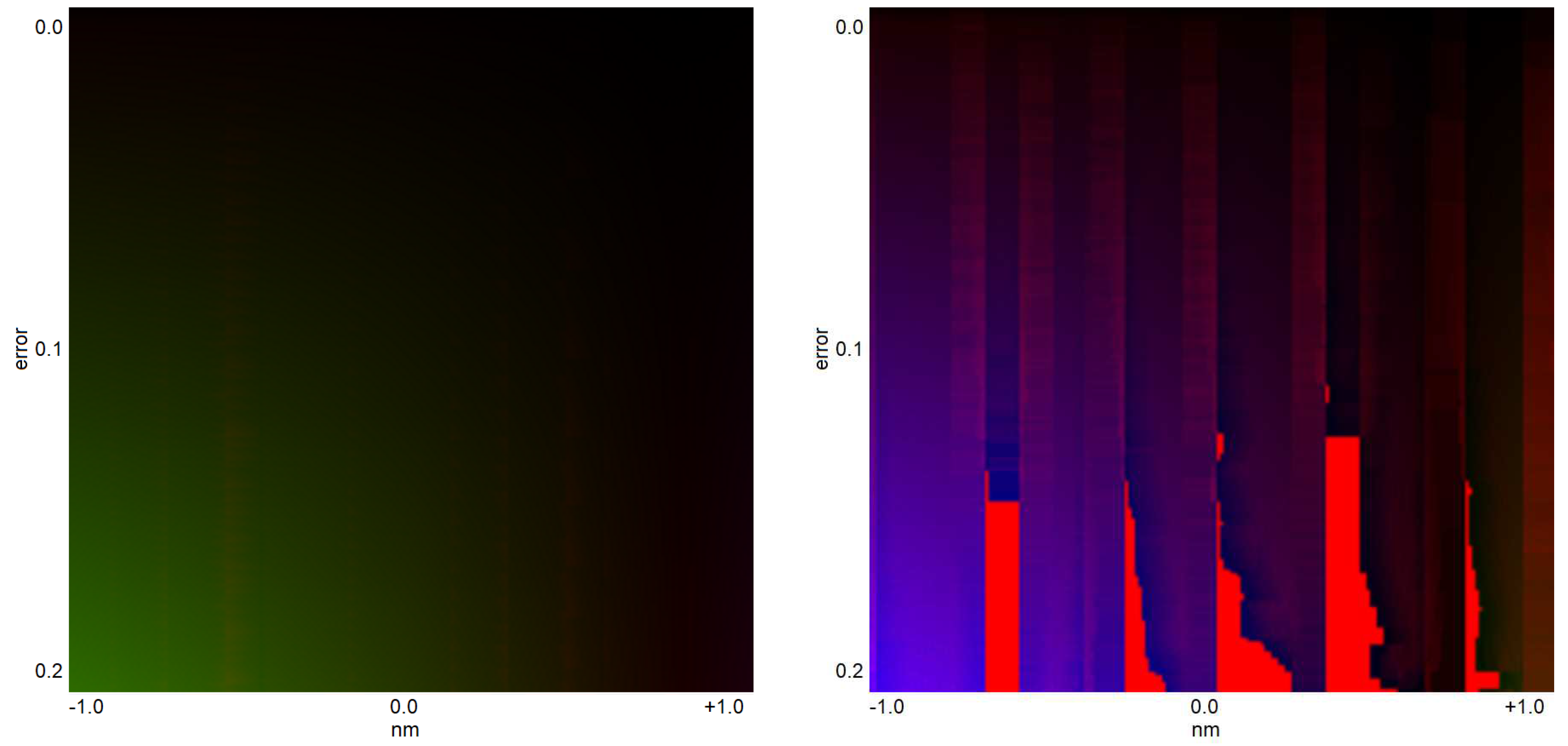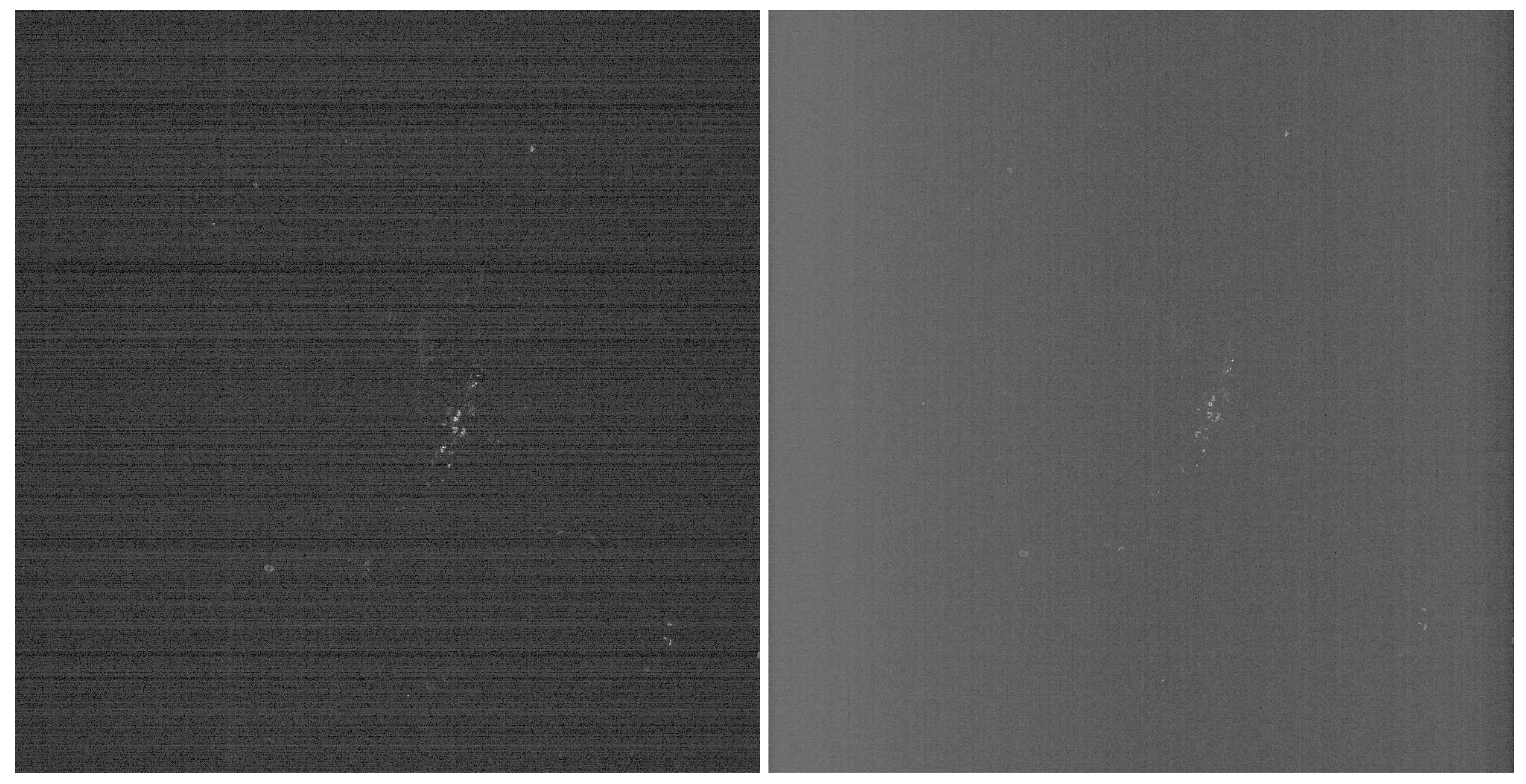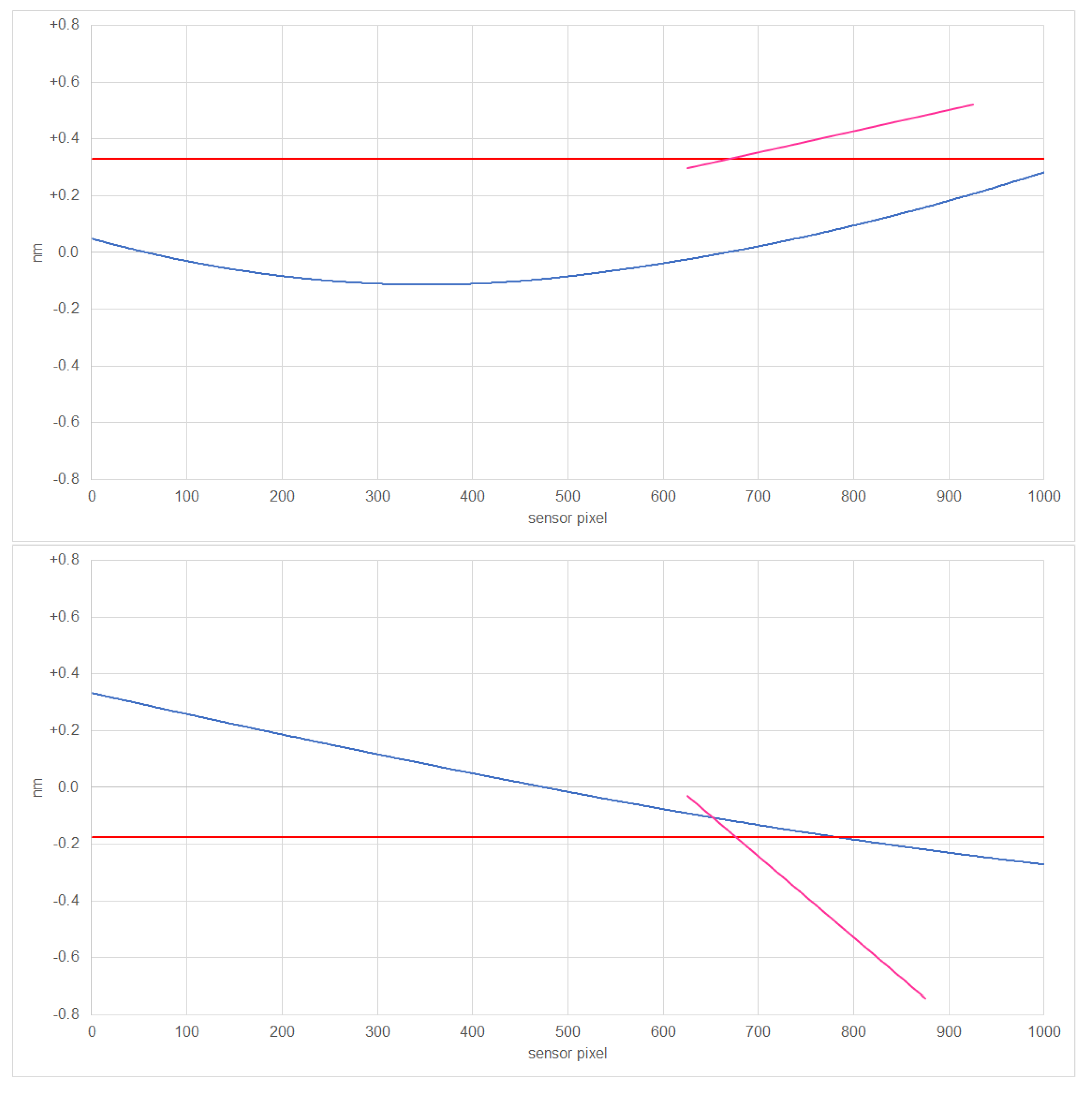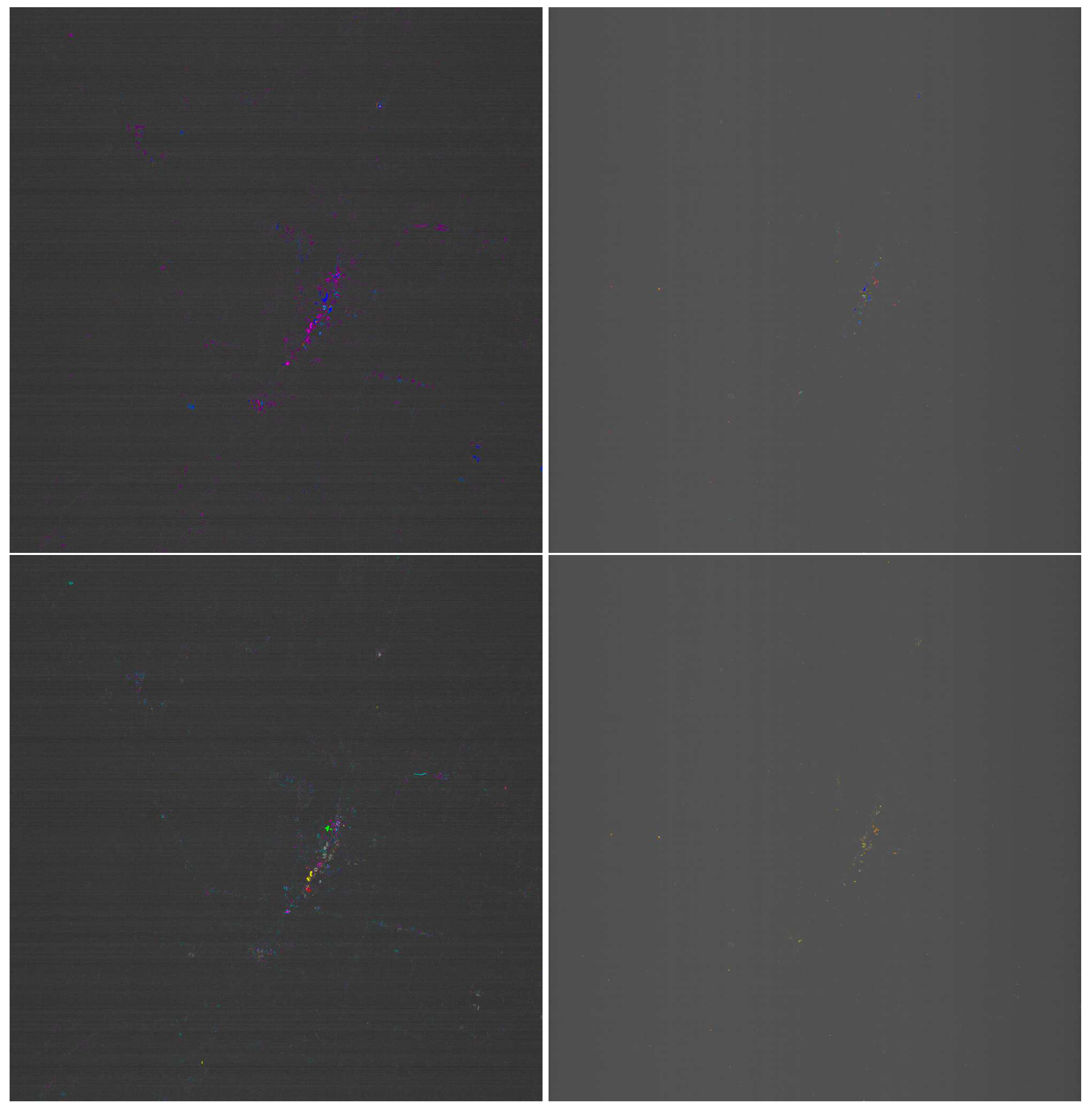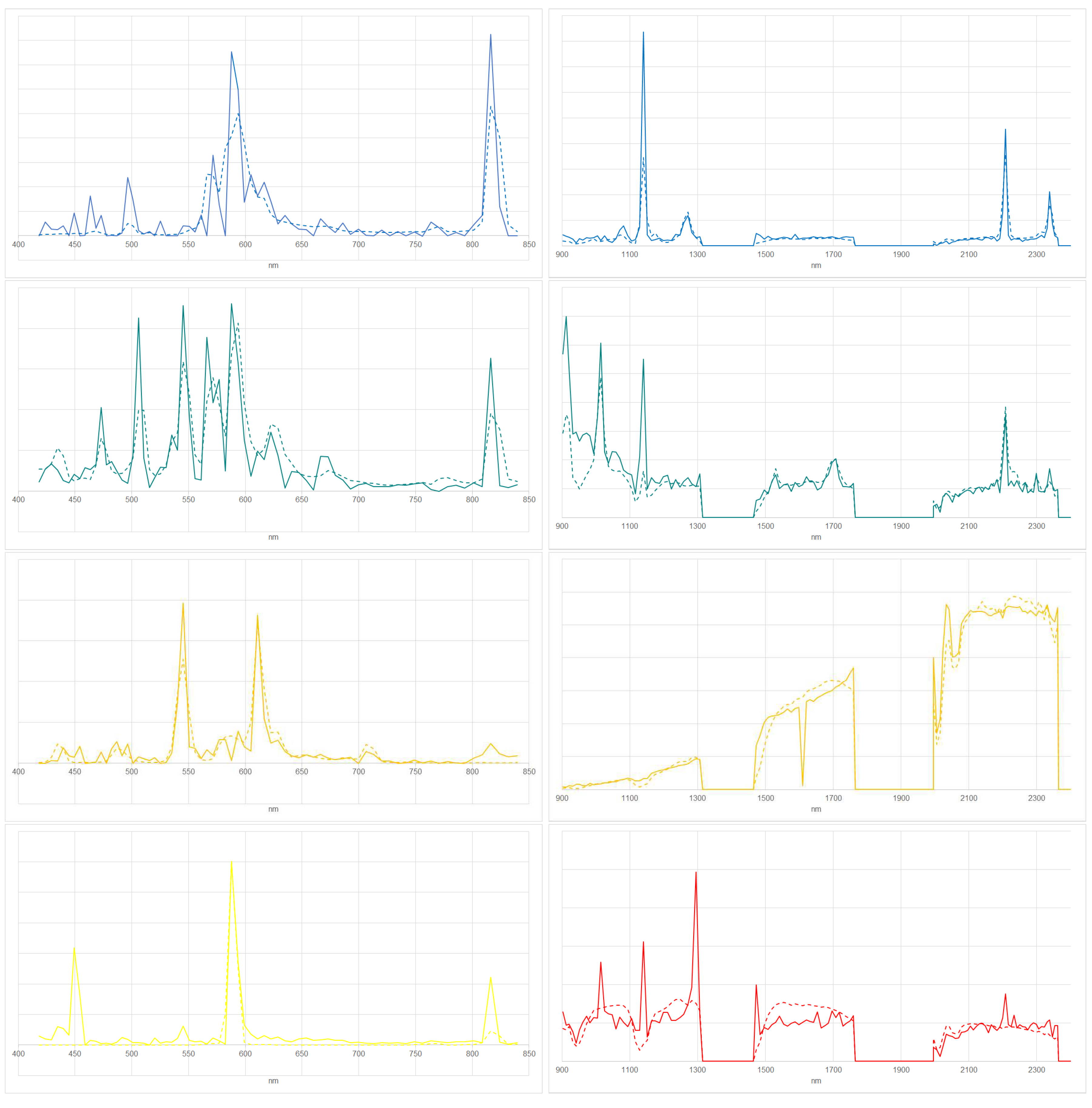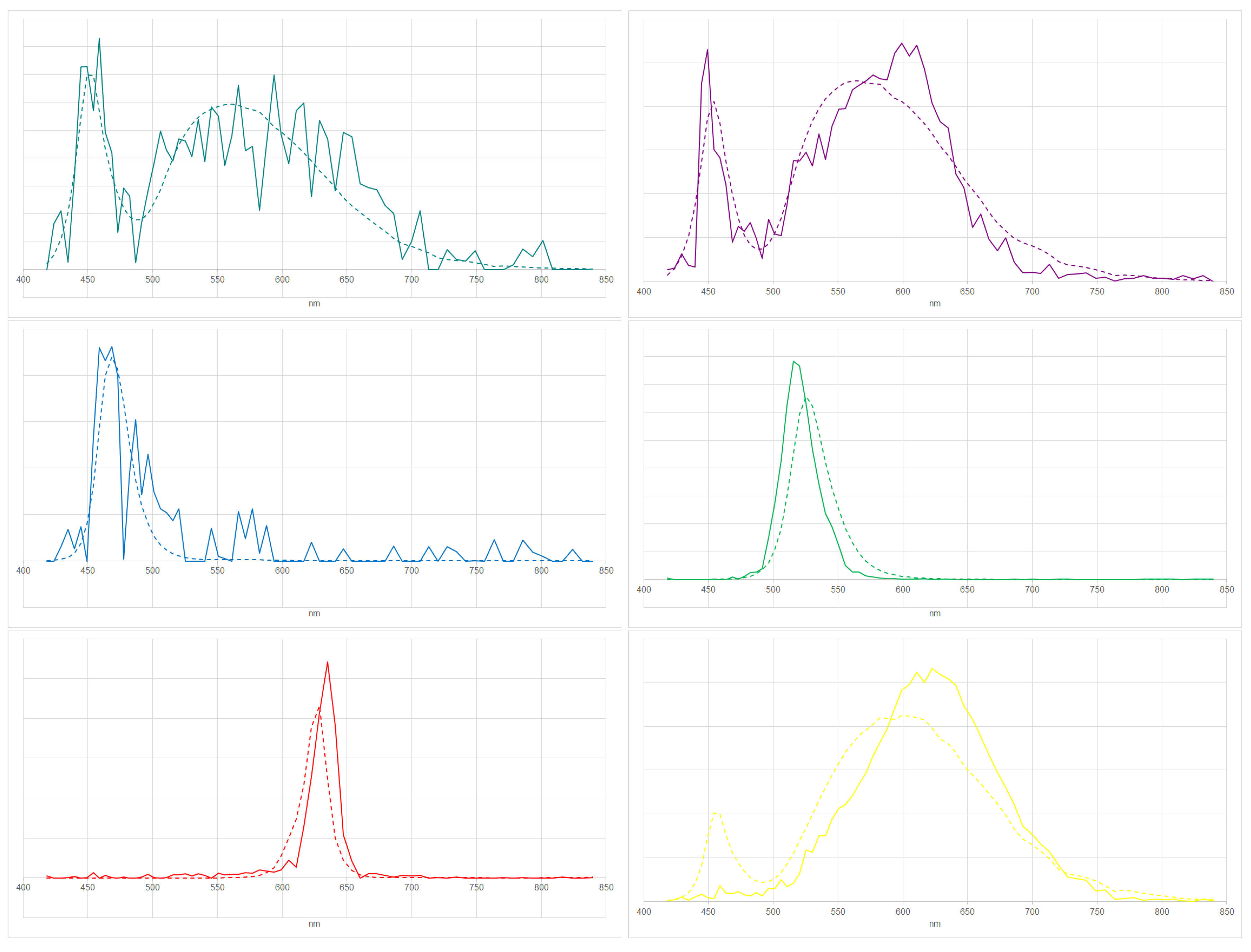2.1. Methods and Results
Within this study, we consider the spectral features of High-Pressure Sodium (HPS), Metal Halide (MH), and Low-Pressure Sodium (LPS) lamps. The spectra of HPS and MH have strong peaks at 819nm and 1,139nm (typically strongest in VIS/NIR and SWIR). And the spectrum of LPS has a medium peak at 819nm and a low peak at 1,139nm. Furthermore, the signals are higher in VIS/NIR than in SWIR. These spectra were measured by [
8] and the sums of the signals normalized to 1 are illustrated in
Figure 3. Other lighting types measured by [
8] do not have strong and narrow emissions in this region as illustrated in
Section 3.2. For VIS/NIR, we even do not expect other strong influences. For SWIR, we do expect some influences based on stronger thermal emissions and resulting from stronger atmospheric absorption effects resulting in higher uncertainties.
We are especially interested in shifts of center wavelengths of the EnMAP bands which is expected to have the major influence on changes of the spectra. To be more precise, we expect constant shifts of the center wavelengths (CW) of the bands in the considered ranges of approx.
nm with respect to the peak of the emission, namely all bands are shifted by the same value, the Full Width at Half Maximum (FWHM) and radiometry are expected to be correct, namely as stated in the metadata of the product, and the Spectral Response Function (SRF) is expected to be a Gaussian function [
24].
Next, in frame of this study we make assumptions, marked as (A#), and analyse these also in relation to uncertainties in
Section 2.2.
First, we consider one of the seven spectra measured by [
8] as reference spectrum (A1), namely the HPS spectrum illustrated in
Figure 3 (red solid line). As the differences of the spectra are limited in the considered ranges and the EnMAP observation is expected to contain a mixture of these spectra, we do expect minor influences on the check of the spectral calibration, here. Furthermore, it is expected, that the luminous efficacy of the lighting types, namely how well a light source produces visible light given by the ratio of luminous flux to power, is improved for 2022 compared to 2010, but most lighting types are not changed and, in particular, the physical properties of the light emissions and resulting spectra have not changed.
EnMAP observes light emissions either directly (i.e., upwards from the light source to the sensor) or indirectly (i.e., downwards from the light source, reflected by the Earth surface, and upwards to the sensor). In both cases the signal is influenced by the path upwards through the atmosphere. Thus, we consider all light emissions per pixel observed either directly or indirectly via a smooth surface (i.e., constant, positive reflectance) in each of the considered ranges (A2). It is expected that most light emissions are observed directly and furthermore, typical surface reflectances are basically smooth and without narrow absorption features in each of the considered ranges [
17]. Therefore, we do expect minor influences on the check of the spectral calibration.
We consider a standard atmosphere (A3), namely an urban mid-latitude summer atmosphere at nadir with a default water vapour of 3,635.9atm-cm [
16], because more detailed information are typically absent, e.g. not stated in the metadata of the product. Because the dynamics of the atmosphere are limited in the considered ranges, namely the change of the atmosphere in the EnMAP observation is limited, the differences of the atmospheric transmission between a maximal, a default, and a minimal water vapour is basically constant in each of the considered ranges as illustrated in
Figure 4, and also other atmospheric parameters have limited non-constant effects, we do not expect major influences on the check of the spectral calibration, here.
Finally, we consider ranges of bands with respect to the peaks of the emission (A4), namely ranges of approx. nm with respect to 819nm for VIS/NIR and 1,139nm for SWIR. These ranges cover symmetrically the complete spectral range around the lighting emission feature, namely low signals (bands and ), medium signals (bands and ), high signals (bands and ), but no other spectral features.
Figure 5 illustrates the resulting image spectra for shifts of the center wavelengths for EnMAP based on the spectral calibration of
nm,
nm, and
nm (bluish, greenish and yellow lines) with respect to the reference spectrum (red line).
To estimate the shift for an image spectrum, we normalize the sum of the signal of the bands in the considered range to 1, in particular for consistent results of the distance measure. Thereby, the absolute signal intensity is excluded in the shift estimation. For the fitting of the image spectrum to the reference spectrum, the error of the normalized signal is used, where the minimum error represents the best fit. We consider the Euclidean distance as the error of two spectra (A5), namely the standard distance measure [
6].
Finally, let us analyse different approaches for selecting an image spectrum to estimate the shift (A6), which is highly relevant for the low signals in nighttime observations. In the next, four cases are investigated: using arbitrary pixel (Arbitrary), using high intensity pixel (Maximum) and sum (or averaging) over all pixel (Sum), and an optimized method based on the results of the first cases.
Arbitrary. In this case we consider an arbitrary image spectrum (light gray lines) of the 1,024,000 image spectra, e.g. the center pixel, and the fitted reference spectrum (light green lines) as illustrated in
Figure 6. We obtain shifts of
nm for VIS/NIR and
nm for SWIR. However, the signals are lower with
W/m
/sr/nm for VIS/NIR and
W/m
/sr/nm for SWIR as also discussed in
Section 2.2. Therefore, major influences of noise are expected and visible through large errors of
for VIS/NIR and
for SWIR. Therefore, for this study this approach seems to be not feasible and is thus discarded.
Maximum. In this scenario we consider an image spectrum with a maximal signal with respect to the considered range (dark gray lines) and the fitted reference spectrum (dark green lines) as illustrated in
Figure 6. We obtain shifts of
nm for VIS/NIR and
nm for SWIR. Now, the signals are higher with
W/m
/sr/nm for VIS/NIR and
W/m
/sr/nm for SWIR. And the errors are
for VIS/NIR, namely smaller as for the center pixel, and
for SWIR, namely larger as for the center pixel. Minor influences of noise are expected, but random effects for a single pixel are expected as illustrated, e.g. based on stronger thermal emissions in SWIR, namely outliers have a major influence the results and the approach seems to be feasible in parts.
Sum. Finally, we consider more than a single image spectrum. To be more precise, we consider the sum of the 1,024,000 image spectra (black lines) and the fitted reference spectrum (blue lines) as illustrated in
Figure 6. We obtain shifts of
nm for VIS/NIR and
nm for SWIR. The signals are highest with
W/m
/sr/nm for VIS/NIR and
W/m
/sr/nm for SWIR. The errors are
for VIS/NIR and
for SWIR. Because most of the incorporated image spectra are of lower signal, raising of the signals and hiding of the reference spectra are expected and visible through close to constant summed image spectra for VIS/NIR and SWIR and the approach seems to be feasible in parts.
Optimum. Based on these results, in particular of the scenarios Maximum and Sum, we consider the image spectra ordered from high signals to low signals with respect to the considered range, namely a mixture of Maximum and Sum. To be more precise, we consider the spectrum
resulting as sum of the image spectra of the
highest signals for
. We already analyzed
and
in the paragraphs Maximum and Sum. Let
be the correspondingly observed error and let
nm be the observed shift. We expect larger changes in the error (and shift), if
i is small, because of the larger influence of random effects for single pixel, as illustrated in
Figure 7 (top). And we expect smaller changes in the error (and shift), if
i is large, because of the smaller influence of an extra pixel, which has at most the same signal influencing the sum as the prior considered pixel, as illustrated in
Figure 7 (bottom). We intent to identify the spectrum
with minimal error
, but for
i large enough to be not strongly affected by outliers. Future research may consider outliers and radiometric uncertainties in a more sophisticated way.
To be more precise, for a given relative deviation in the error , let , namely the first index such that for all consecutive indices of at least the relative deviation in the error is at most e, and let , namely the first index of at least with a minimal error. We consider (A5), namely the relative deviation in the error shall be at most 1%.
Finally, we obtain
nm for VIS/NIR and
nm for SWIR, where
,
, and
for VIS/NIR as well as
,
, and
for SWIR.
Figure 6 illustrates the spectra of the optimally summed image spectra (yellow lines) and the fitted reference spectra (red lines).
2.2. Sensitivities and Influences of Assumptions
In the following, we analyze the sensitivity of the method and the influences of the assumptions made in Chapter 2.1, resulting in the expected uncertainty range of this approach.
Sensitivity to noise. For the analysis of sensitivity to noise of the estimated shifts, we expect that the spectra are predominantly affected by signal independent Gaussian noise and only to a small degree affected by signal dependent shot noise [
22], because of the low signals, e.g. by comparing the optimally summed image spectra and the fitted reference spectra as illustrated in
Figure 6. Furthermore, we expect that the noise is equally distributed to all bands, because, e.g. by examining half of the image spectra with the lower signals in the considered range, we obtain
for VIS/NIR signals, averaged for each band, in the range of W/m/sr/nm with standard deviations in the range of and
for SWIR signals, averaged for each band, in the range of W/m/sr/nm with standard deviations in the range of ,
namely, basically constant signals, averaged for each band, with constant standard deviations. Furthermore, for these image spectra, we obtain
for VIS/NIR a signal, averaged for all bands, of W/m/sr/nm with a standard deviation of , namely an expected relative deviation of the signal of , and
for SWIR a signal, averaged for all bands, of W/m/sr/nm and a standard deviation of , namely an expected relative deviation of the signal of .
Based on these estimates for the given case, the noise contribution is larger in VIS/NIR than in the SWIR.
For estimating the sensitivity, we add noise to the reference spectrum and change its shift to achieve an observed error and shift. In particular, if some ratio of the signal of the normalized, not noisy, shifted by nm, reference spectrum with is equally added to each of the b considered bands as noise, namely the noisy, shifted by nm, reference spectrum is considered, we obtain an observed error and shift.
To be more precise, we consider the mapping
. This mapping
f is not necessarily bijective, in particular not unambiguous, because different combinations of
r and
c may result in the same observed error
and shift
, namely
f is not injective as
, or no combinations of
r and
c may result in some observed error
and shift
, namely
f is not surjective as
. The mapping
f is illustrated in
Figure 8.
Consequently, the influence of noise for the observed errors and shifts in
Section 2.1 is as follows. For the VIS/NIR, the estimates have minimal ambiguities
and just a minor change in the spectral shift of
nm. For the SWIR, ambiguities increase to
and a related major change in the shift of
is observed.
Because of the observations on noise, namely accounting for the expected relative deviations of the signals, averaged for all bands, of
for VIS/NIR and
for SWIR, we consider ratios
for VIS/NIR and
for SWIR. In other words, we consider some more added noise to the reference spectrum. Hence, at most all
for
, namely
is not considered as outlier, and where
for
and any
c, are shifts not violating the expected deviations of the observed errors. We obtain ranges
for VIS/NIR and
for SWIR and by considering any
c, where
for
,
and any
, we obtain results on uncertainties based on sensitivity as stated in
Table 1. We remark, at least for the considered ranges, the values of
and
r are strongly correlated by a constant positive factor. Because, e.g.,
for VIS/NIR and
for SWIR,
Figure 7 (lines 1 and 2) indicates these ranges of
D and
Figure 8 indicates the resulting differences, namely uncertainties. We remark,
nm is always contained in the ranges, here, because for
the noisy and not noisy spectra equal.
A1—influence of lighting types. Let us consider assumption A1 and each of the seven spectra measured by [
8] as reference spectrum (
HPS,
MH,
LPS). We obtain shifts of:
| |
reference |
|
|
|
|
|
|
| |
HPS 1 |
HPS 2 |
HPS 3 |
MH 1 |
MH 2 |
MH 3 |
LPS |
| VIS/NIR |
nm |
nm |
nm |
nm |
nm
|
nm |
nm
|
| SWIR |
nm |
nm |
nm |
nm |
nm |
nm
|
nm
|
Because of lower signals for LPS in VIS/NIR and SWIR, and as mixtures of such spectra are expected, we do not account for (and to avoid drifts both) the minimum shifts, marked by (1), and maximum shifts, marked by (2). As expected, the differences in the shifts are marginal and we obtain results on the uncertainties based on A1 as stated in
Table 1. We remark, that the average shifts are
nm for VIS/NIR and
nm for SWIR and, in particular for VIS/NIR, these shifts are close to the shifts for the reference spectrum.
A2—influence of surface types and upward vs. downward illuminations. Let us consider assumption A2 and a smooth surface reflectance, absorption depths
of low (00.1%), medium (01.0%), and high (10.0%) and absorption widths
of low (001nm), medium (010nm), and high (100nm) applied to the constant, positive surface reflectance. In other words, if a signal is a combination of, e.g., 90% directly observed light emission and 10% indirectly observed light emission via a surface with a positive reflectance, and now a high absorption depth of 10.0% is applied to the surface, namely the surface reflectance is changed by a factor of 90.0%, then a signal of
results. We remark, that the result is the same as for, e.g., 0% directly and 100% indirectly observed light emission and applying a medium absorption depth of 01.0%. To be more precise, we model absorption of
at a specific wavelength of
nm by a linearly descending absorption to the constant, positive surface reflectance by a factor of
at
nm to
for increasing distances to
nm, where the Full Width at Half Maximum is given by
. Considering all
nm, we obtain shifts of:
| VIS/NIR |
low depth (00.1%) |
medium depth (01.0%) |
high depth (10.0%) |
| low width (001nm) |
|
|
|
| medium width (010nm) |
|
|
|
| high width (100nm) |
|
|
|
| SWIR |
low depth (00.1%) |
medium depth (01.0%) |
high depth (10.0%) |
| low width (001nm) |
|
|
|
| medium width (010nm) |
|
|
|
| high width (100nm) |
|
|
|
As expected, the extends of the ranges increase by increasing the absorption depths and are larger for medium widths, because for low widths the influence to a single band is limited and for large widths the influence to all bands is similar. We account for the minimum and maximum shifts for all considered combinations of
and
and we obtain results on the uncertainties based on A2 as stated in
Table 1.
A3—influence of atmospheres. Let us consider assumption A3 and next to the default atmosphere, atmospheres with a maximal (but not cloudy) and a minimal water vapour of 6651.1atm-cm and 1817.9atm-cm, that is half of the default water vapour, as illustrated in
Figure 4. Because the water vapour has the highest influence on the atmospheric absorption, we do not consider changes of the other parameters. We obtain shifts of
nm and
nm for VIS/NIR, and
nm and
nm for SWIR. In particular for VIS/NIR, the shifts are close to the ones for the default atmosphere, because the dynamics of the atmosphere are limited in this wavelength range. And we obtain results on the uncertainties based on A3 as stated in
Table 1. We remark, if we do not account for the atmosphere at all, shifts of
nm for VIS/NIR and
nm for SWIR result, that are as expected close to the shifts considering the default atmosphere.
A4—influence of range of bands around the lighting emission peaks. Let us consider assumption A4 and next to the default range of
bands,
bands and
bands around the lighting emission peaks, namely 819nm for VIS/NIR and 1,139nm for SWIR. We obtain shifts of
nm and
nm for VIS/NIR and
nm and
nm for SWIR. Again, in particular for VIS/NIR, these are close to the shifts for the default range of bands. And we obtain results on the uncertainties based on A4 as stated in
Table 1. This assumption is already incorporated by the considerations of sensitivity, namely changes of the considered bands will result in corresponding changes in the sensitivity, and therefore, not relevant for uncertainty estimations. However, the results illustrate the robustness of the considered method.
A5—influence of distance metrics. Let us consider assumption A5 and for normalized image spectra
and reference spectra
next to the default Euclidean distance
, the Manhattan distance
and the distance
. We obtain shifts of
nm and
nm for VIS/NIR and
nm and
nm for SWIR, namely, in particular for VIS/NIR, close to the shifts for the default distance measure. And we obtain results on the uncertainties based on A5 as stated in
Table 1. This assumption is already incorporated by the considerations of sensitivity, namely changes of the considered distance measure will result in corresponding changes in the sensitivity, and therefore, not relevant for uncertainty estimations, here. However, the results illustrate the robustness of the considered method.
A6—influence of image spectra selections. Let us consider assumption A6 and next to the default relative deviation in the error of , and —as well as , , and for later investigations—, namely lower and higher values as the default. We obtain shifts of:

Because
for VIS/NIR, this may be seen as some indicator, that
is a too conservative value, here, but nevertheless the shift for
is close to the one for
and for SWIR
. Furthermore, for
we obtain
for VIS/NIR and SWIR. And we obtain results on uncertainties based on A6 as stated in
Table 1. Because all these observed errors and shifts are already incorporated by the considerations of sensitivity, this assumption is not relevant for uncertainty estimations, here. We remark, if we consider
and
, namely we do not consider
e at all, but any optimum, we obtain the same shifts as for
. Furthermore, because
for VIS/NIR and SWIR, this may be seen as strong indicator, that
is a too conservative value, here.
Summary of A1 to A6. Assuming to the worst that all these estimated uncertainties typeset bold in
Table 1 are correlated, namely the ranges need to be added, we obtain total uncertainties as stated in
Table 1, namely expected shifts of
nm in the range
for VIS/NIR and
nm in the range
for SWIR. These values—even the estimated shifts and not considering the estimated uncertainties—are well within the accuracy of
nm for the spectral calibration based on laboratory calibrations and dedicated satellite equipment [
24]. We remark, assuming shifts of
nm for VIS/NIR and
nm for SWIR lead to symmetric uncertainties of
nm for VIS/NIR and
for SWIR.
In addition to the investigation of other spectral features of light emissions, future research may consider atmospheric absorption features such as the Oxygen A band absorption at 760nm or the CO absorption at 2,060 for homogeneous light or thermal emissions in that range.
Figure 9 illustrates for the complete EnMAP tile the integrated signals for each pixel accounting for the bands in the considered range, where for illustration purposes instead of signal
L the value
is considered. We remark, for VIS/NIR, marginal systematic striping effects in along-track direction and for SWIR, marginal systematic higher signals at the borders compared to the center in across-track direction are visible.
Spectral Along-Track Stability. Another aspect is to check the spectral stability over short time intervals, i.e. in along-track direction. If we split the EnMAP tile into the first half and second half in along-track direction, we observe that pixel with high signals are located in both halves and we obtain shifts of nm (with error ) and nm (with error ) for VIS/NIR and nm (with error ) and nm (with error ) for SWIR. All these estimated shifts are close to the estimated shifts for the complete EnMAP tile and, in particular, well within the estimated uncertainties. Thus for this given scene the described approach allows for the estimation of short time stability, which is given for EnMAP.
Spectral Across-Track Characteristics. As hyperspectral push-broom sensors often exhibit a slight change in center wavelengths in across-track direction (often denoted as spectral smile), this sensor property is also assessed with this method. For the EO tile, we observe that pixel with high signals are located, in particular, between approx. pixel 570 and 630 in across-track direction or of the sensor. To be more precise, for the average—weighted based on the considered signals of the considered pixel—sensor pixel is for VIS/NIR and for SWIR. For these sensor pixel shifts of nm for VIS/NIR and nm for SWIR are expected according to the spectral calibration based on laboratory characterization. Therefore, accounting for the shifts of these sensor pixel, too, we assume shifts of nm for VIS/NIR and nm for SWIR.
To analyze the spectral smile, we separate the 1,000 valid sensor pixel per band to 4 parts of 250 pixel each. We consider the two parts with lowest fitting error. And we obtain shifts of
nm (with error
) and
nm (with error
) for the 3
rd and 4
th part of VIS/NIR (all other parts have errors of at least
) and
nm (with error
) and
nm (with error
) for the 3
rd and 4
th part of SWIR (all other parts have errors of at least
).
Figure 10 illustrate these results. All these results are well within the estimated uncertainties.
For VIS/NIR, the estimated smile is highly consistent, being close to the estimate using a across-track constant fitting, and showing the same across-track slope as the smile based on laboratory calibrations. For SWIR, where the uncertainties are estimated to be much larger as for VIS/NIR, the estimated shifts are decreasing with increasing across-track pixel as for the spectral calibration based on laboratory calibrations, but the magnitudes of changes are not consistent.

